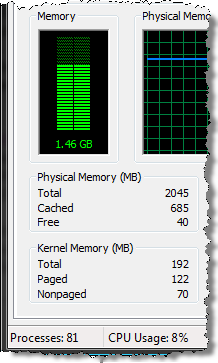The Vista RAM puzzle: Is 2GB enough?

A couple weeks ago, my buddy Dwight Silverman asked whether he should be tempted by low, low prices to bump the RAM in his Windows Vista machine from 2GB to 4GB. He asks:
My problem is this: I want the RAM, but do I really need it? I seldom, if ever, use all the memory now in my PC -- the RAM gauge I use as part of Yahoo Widgets seldom goes above 65 or 75 percent. I have no performance complaints. (I also use a 2-GB USB flash drive for Vista's ReadyBoost, which helps.) Would spending $80 to kick my RAM up a single gigabyte to 3 GB be worth it? Would I be better off spending $160 and going to 4 GB?

I've used Vista on more than a dozen machines from at least six manufacturers. Currently, my working machines are an Asus Tablet PC and a Dell XPS 410 desktop, both with 2GB of memory. In more than a month of sometimes insanely heavy use with each one, I have never reached a state where either one performed unacceptably because it was gasping for RAM. It's really, really difficult to use 2GB of RAM with any edition of Windows Vista. At the moment, as you can see from the Task Manager snippet on the right, I'm running 81 processes on this desktop PC, including the following:
- Two instances of Internet Explorer 7 with a total of 40 tabs open (note that this load would have brought the system to its knees if I hadn't also increased the size of the desktop heap)
- Firefox 2.0.0.6 with five Ajax-heavy tabs in use
- Adobe Acrobat Standard
- Outlook 2007, with a 610MB OST file synching with an Exchange Server about 2000 miles away
- Two remote sessions, one to Windows Home Server (via its own console), the other to Windows Server 2008 (via Remote Desktop).
- OneNote, with 90MB of notebook files open
- Four Windows Sidebar gadgets
- Windows Media Player, connected to a library of 20,000 songs and pictures stored on a Vista-based media server in the living room
- 11 Windows Explorer windows representing local folders, network shares, searches, and bits of the Windows Control Panel like the Installed Programs list, Network and Sharing Center, and Sync Center
- A bunch of useful programs running in the background, including RoboForm, ClipMate, SnagIt, the Windows Home Server Connector, and Windows Live Messenger
- Oh, and I'm composing this in Windows Live Writer
That's a lot of stuff, but I'm not even close to using up the 2GB of RAM installed on this machine. According to Task Manager, 1.44GB are in use by all processes from all users, including caches and indexing tasks and other system functions. From experience, I know I could open another half-dozen programs and rip a music CD and still not notice any change in performance.
If you use a similar mix of apps, you should see similar results. For that type of heavy multitasking, the bump from 1GB to 2GB has a clear impact and costs very little. But adding an extra 2GB beyond that doesn't usually result in any noticeable improvement in performance or reliability.
As I noted earlier, there are two big exceptions to this general advice. The first is virtualization. If you run Linux or Windows (any version) in one or more virtual machines on the same PC, you'll hit that 2GB ceiling sooner rather than later. In that case, you need extra RAM. You also need to join the second group and go to 64-bit Windows Vista, which can actually use all that RAM (with 32-bit Windows versions, you can only use roughly 3GB of RAM, regardless of how much is physically installed).
For the past few months, I've been switching between 32-bit and 64-bit Windows Vista machines. Thanks to the wonderful new VMWare Workstation 6, I think I'm about to go all 64-bit on the desktop. I'll have more on why VMWare and 64-bit Vista are such a great match (and why licensing issues are still such an unnecessary hassle) in my next post.